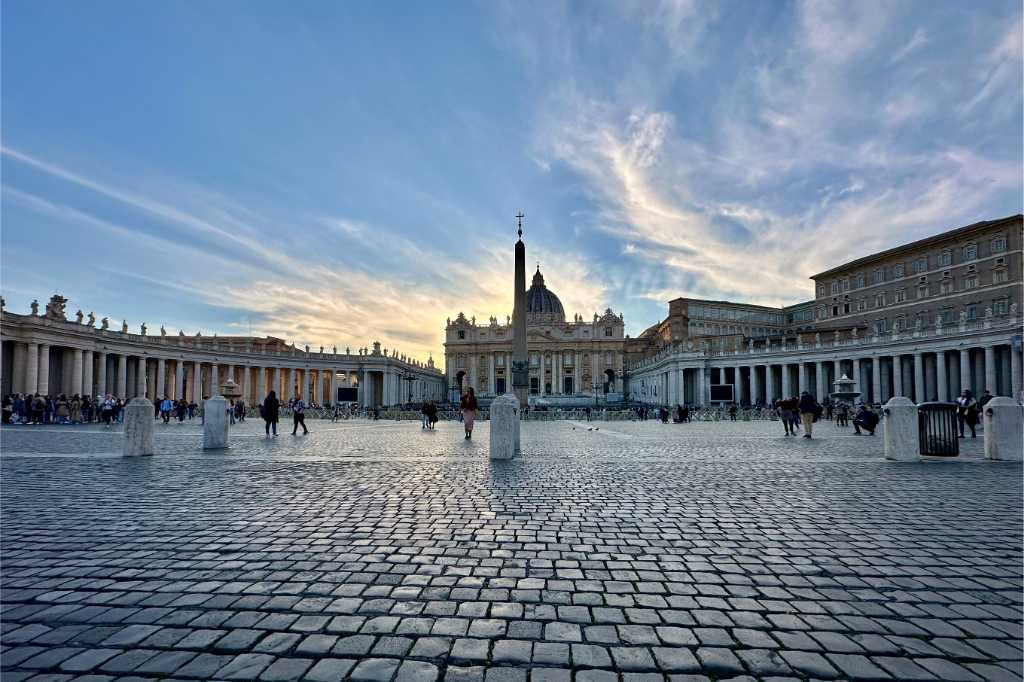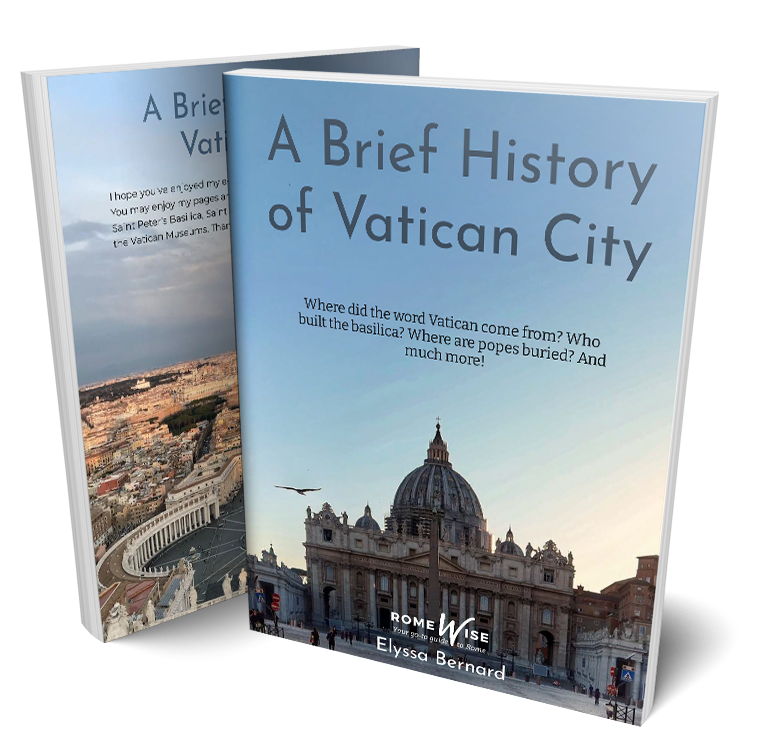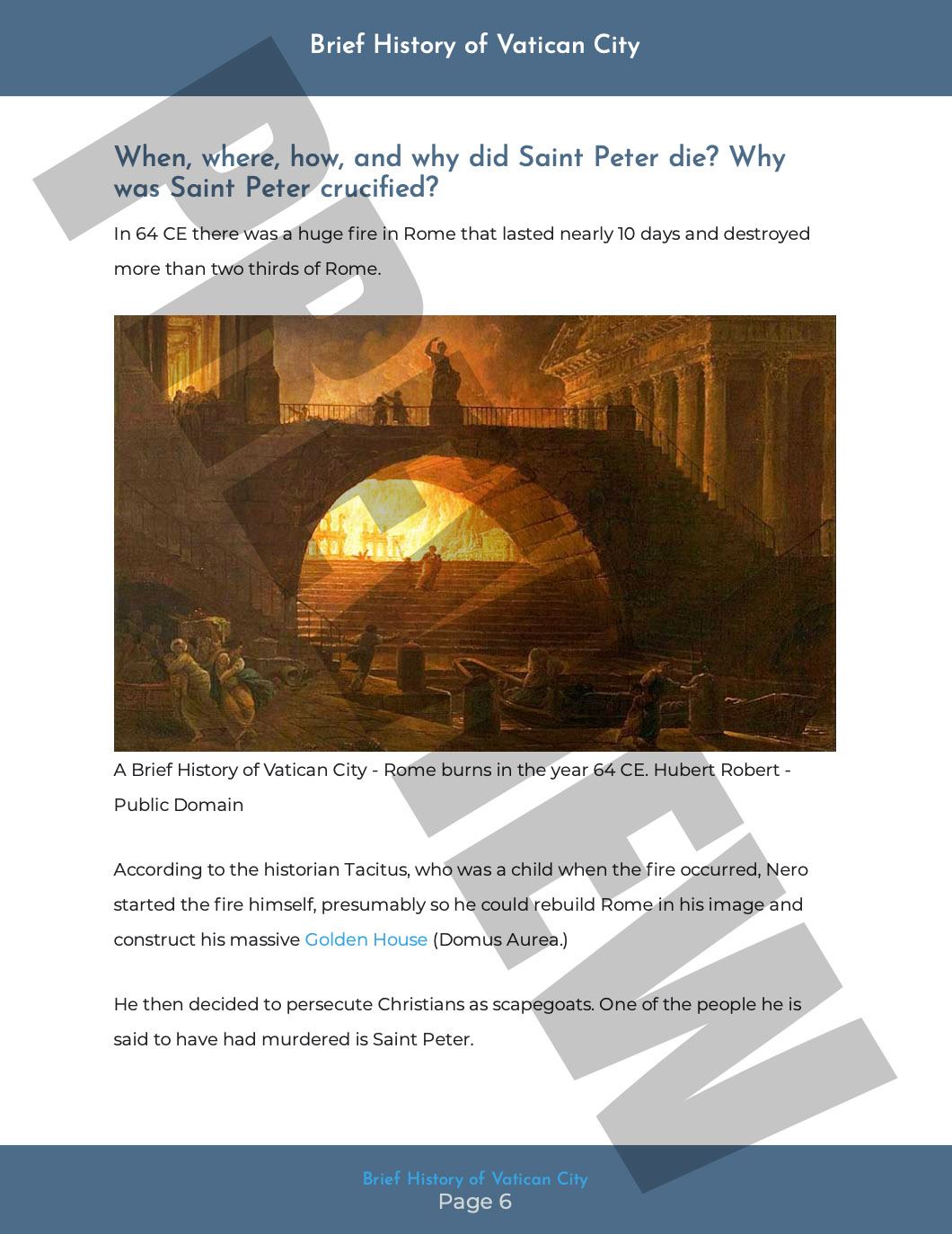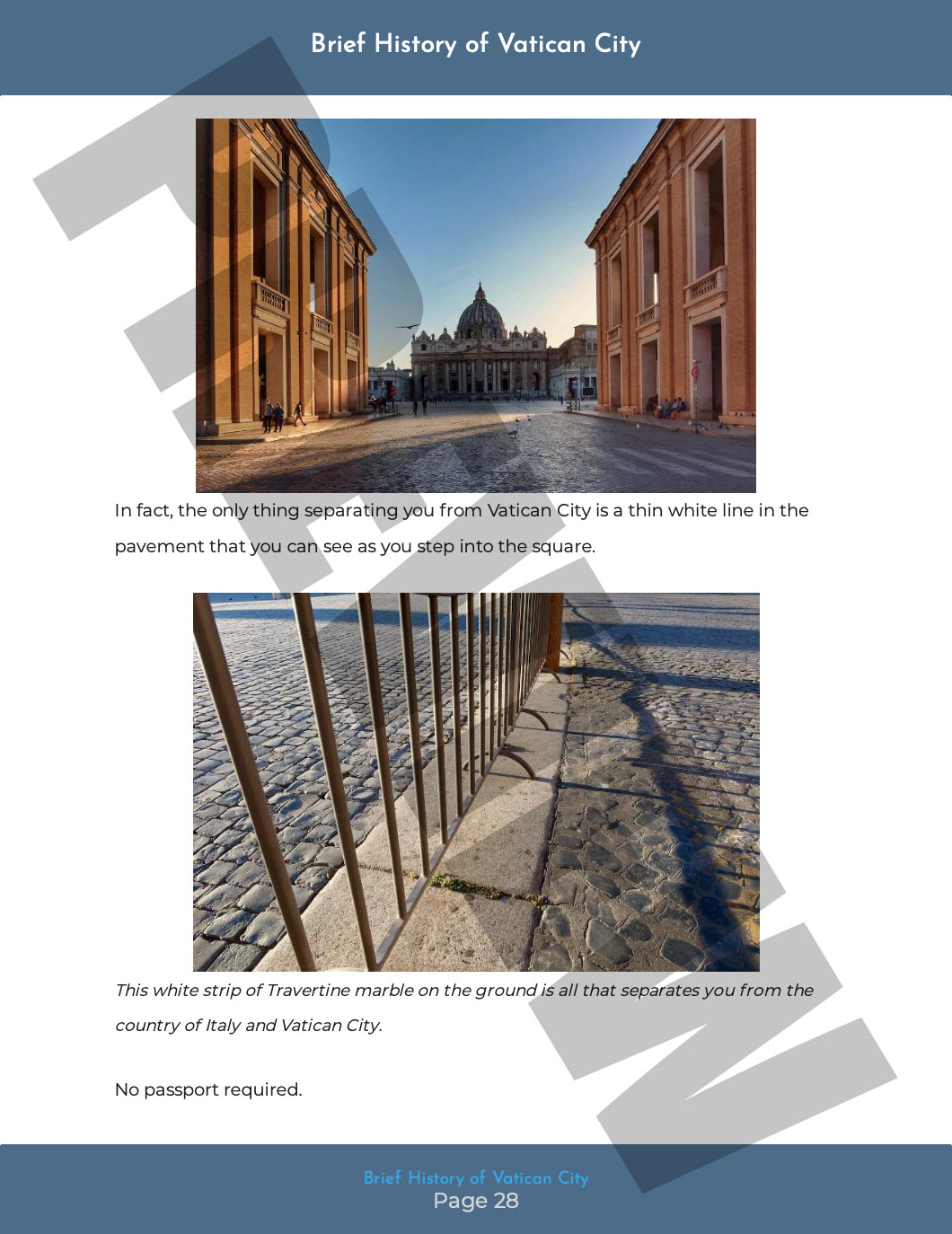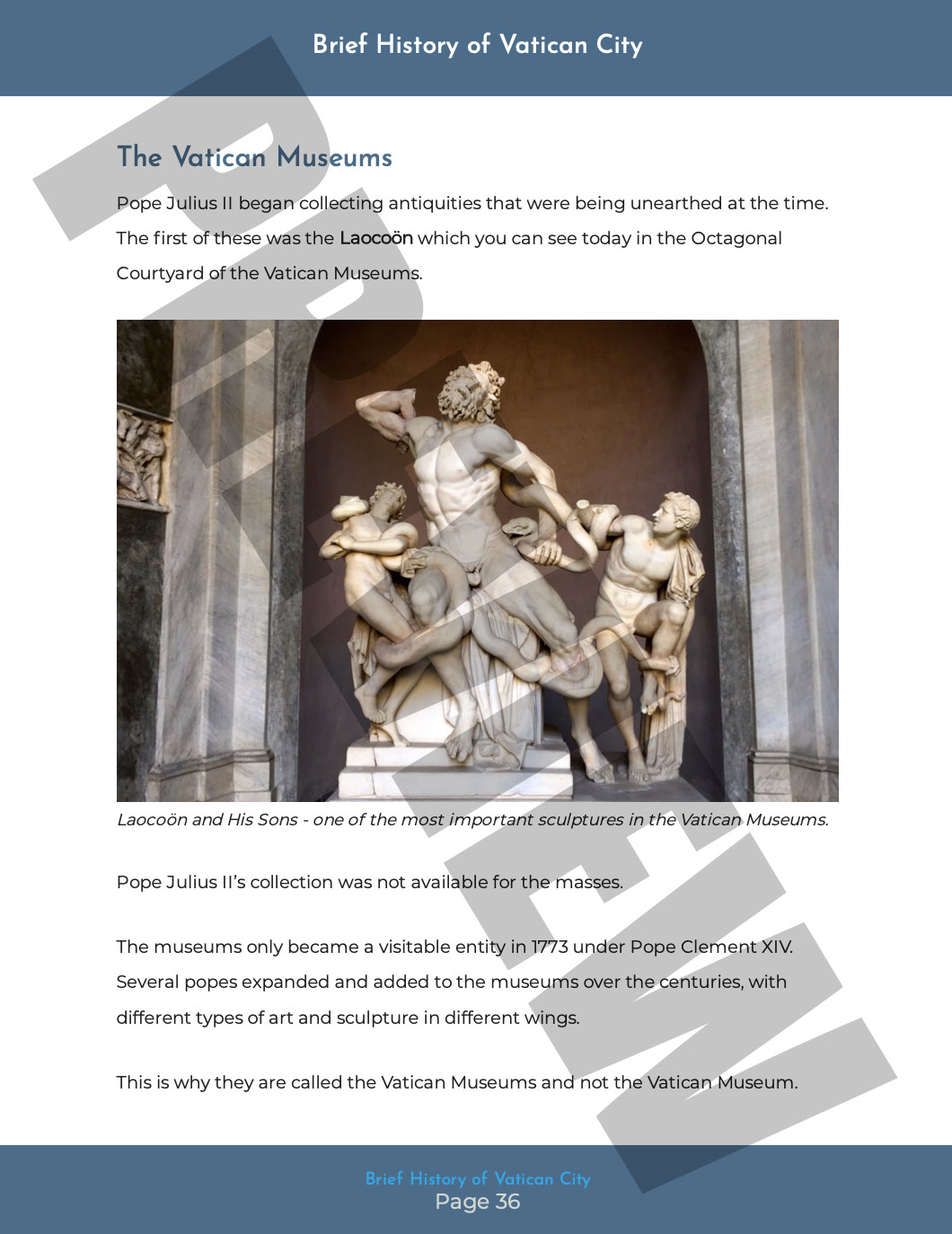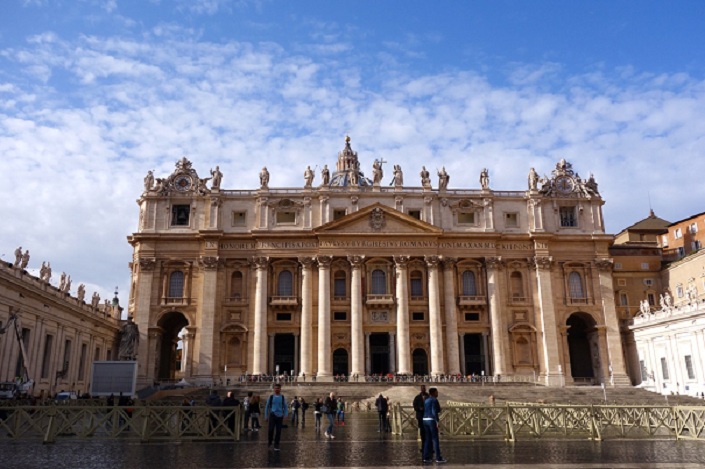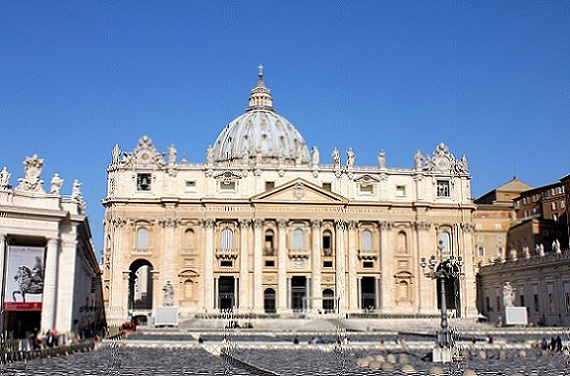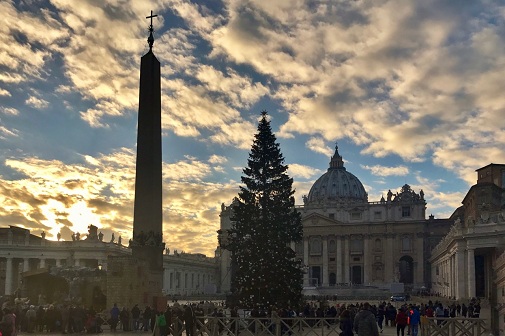- Sign up & get a FREE ebook Subscribe NOW!
- Romewise Home Page
- Visiting the Vatican
- St Peters Square
St Peters Square - One of Rome's Most Stunning Piazzas
Every time I set foot in St Peters Square, I am taken aback.
I try to take it all in; St Peter's Basilica as backdrop, the perfectly symmetrical columns of Bernini's colonnade, the ancient Egyptian obelisk, the Baroque beauty of the façade and fountains.
Everything You Need to Know About St Peters Square
If you're visiting Rome, chances are you are also visiting the Vatican.
Whether you visit St Peter's Basilica and/or the Vatican Museums (to see the Sistine Chapel), you can easily visit St Peter's Square. And if you do, you can say that you've visited a whole different country than Italy.
As one of my absolute favorite places in the Eternal City, and one of the locations I have an infinite number of pictures of, I'm here to tell you everything you need to know about St Peters Square in Rome, including:
- What is Saint Peter's Square and why should you see it?
- A brief history of St Peter's Square, including who designed it
- Why is there an ancient Egyptian obelisk in St Peter's Square?
- Interesting things to see in St Peter's Square
- What events take place in St Peters Square?
- When can you visit Saint Peters Square?
- How to reach St Peters Square?
What is Saint Peter's Square and Why Should You See it?
St Peter's Square, Piazza San Pietro in Italian, is the huge open-air space in front of Saint Peter's Basilica in Vatican City.
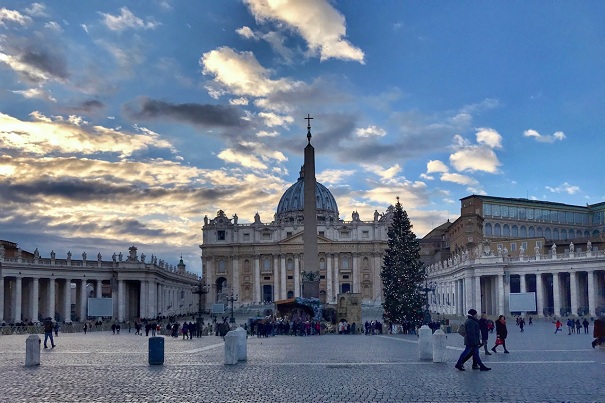 Visiting St Peters Square is especially moving at Christmas when the tree and nativity scene are up.
Visiting St Peters Square is especially moving at Christmas when the tree and nativity scene are up.The first impact it has on me is the sheer size, 320 meters long and 240 meters wide at the ellipse (1050 x 787 feet).
The second thing that strikes me is the jaw-dropping symmetry of the colonnade, wide open in embrace.
Once I let this feeling wash over me, I take in all the elements that make the piazza so beautiful. The ancient Egyptian obelisk at the center, the twin fountains on either side, their sparkling water droplets reflecting the sunlight, and of course, one of the most beautiful basilicas in the world.
A Brief History of St Peter's Square
The Original Basilica of Saint Peter
The basilica of St. Peter you see today was built mostly during the Renaissance.
The original basilica, now referred to as "Old Saint Peter's" was built during the reign of Roman Emperor Constantine in the 4th century.
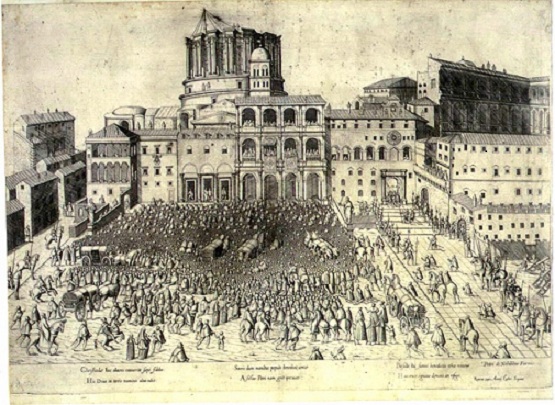 This engraving shows a crowd in St Peters Square with the Basilica of St Peter's dome under construction. You can see the Vatican Palace on the right. This is also before the obelisk was moved here. By Antonio Lafreri - Public Domain 1555
This engraving shows a crowd in St Peters Square with the Basilica of St Peter's dome under construction. You can see the Vatican Palace on the right. This is also before the obelisk was moved here. By Antonio Lafreri - Public Domain 1555By the late 15th century, it was literally falling apart and leaning heavily to one side so in 1506 Pope Julius II ordered a new basilica built.
The New St Peter's Basilica
Many artists and architects were involved in the design of the current basilica, most famously Michelangelo.
The basilica was officially finished in 1626, but now that the final church was so stunning, it was time to turn to the space in front of it.
At this point, the only thing there was the ancient Egyptian obelisk that Domenico Fontana had moved there only decades prior (see below for how that came about).
There is a saying that "Michelangelo designed Saint Peter's Basilica and Bernini decorated it."
While many artists and architects were involved in the design of this monumental church, without a doubt these two men were among the most famous.
Pope Alexander VII Involves Bernini
There are some theories that suggest Bernini may also have been influenced by heliocentric theory, which was considered heretic by the Church at the time.
In 1655 Fabio Chigi became Pope, taking the name of Alexander VII. He was an intelligent and well-read man with a taste for literature and the arts.
On the day he was elected, Pope Alexander VII summoned Gian Lorenzo Bernini to discuss ideas for repurposing the space in front of Saint Peter's Basilica.
Bernini had already been working on the interior of the basilica for decades. Most famously, he'd made the "baldacchino", or bronze canopy above the papal altar.
Bernini conceived of the wide-open elliptical design you see today, as a way to give a sense of the church welcoming the faithful and non-faithful alike. The idea was also to awe and convert infidels, "enlightening them about the true faith" (Bernini).
Finally, Bernini wanted to make sure as many people as possible could watch the Pope when he addressed the crowds from above.
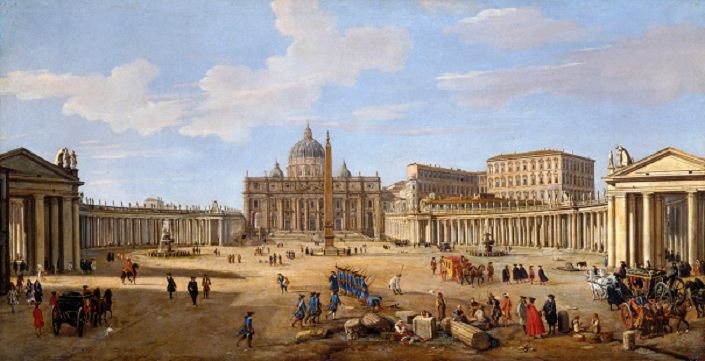 Painting of Bernini's colonnade and complete redesign of St Peters Square by Gaspar van Wittel, circa 1700.
Painting of Bernini's colonnade and complete redesign of St Peters Square by Gaspar van Wittel, circa 1700.Construction of the piazza began in 1656 and was completed in 1667.
The project used 44,000 cubic meters of travertine stone (brought from nearby Tivoli) and required hundreds of workers.
Why is There an Ancient Egyptian Obelisk in the Square?
In the middle of St Peter's Square stands an un-inscribed Egyptian obelisk made of red granite. It is one of 8 ancient Egyptian obelisks in Rome.
The obelisk was originally erected in the Temple of the Sun in Heliopolis (today part of Cairo), Egypt. It's possible it was built under Pharaoh Mencares in 1835 BCE. Other scholars think it may have been carved during the reign of Nebkaure Amenemhet II (1992 - 1985 BCE).
The Obelisk Comes to Rome
Either way, around 30 BCE, the Roman prefect Cornelius Gallus raised the obelisk in the Forum Iulium in Alexandria, Egypt by order of Rome's first Emperor, Augustus.
In 37 CE the 3rd Roman Emperor, Caligula, had the obelisk transferred to Rome. It was lowered onto rollers, and moved to a specially constructed ship.
You can see an image of what this was like in the Gallery of the Maps in the Vatican Museums.
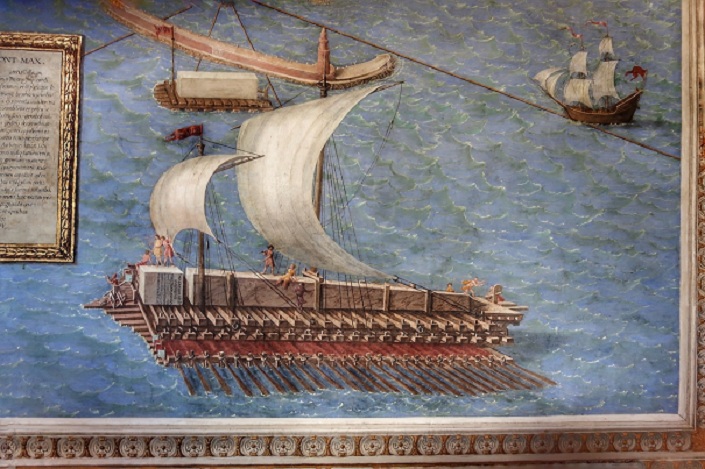 I love this little painting in the Maps Gallery of the Vatican Museums. It's along the left wall, all the way at the end, almost as you exit the Maps room. This picture depicts and Egyptian obelisk being shipped to Rome on a specially-made boat.
I love this little painting in the Maps Gallery of the Vatican Museums. It's along the left wall, all the way at the end, almost as you exit the Maps room. This picture depicts and Egyptian obelisk being shipped to Rome on a specially-made boat.There are 13 ancient obelisks in Rome but the other 5 were Roman-made.
Read more about them on our dedicated page about obelisks in Rome.
The obelisk was placed on the central spine of the Circus of Caligula, where chariot races and other games were held.
This circus later became known as the Circus of Nero, named for Rome's fifth emperor.
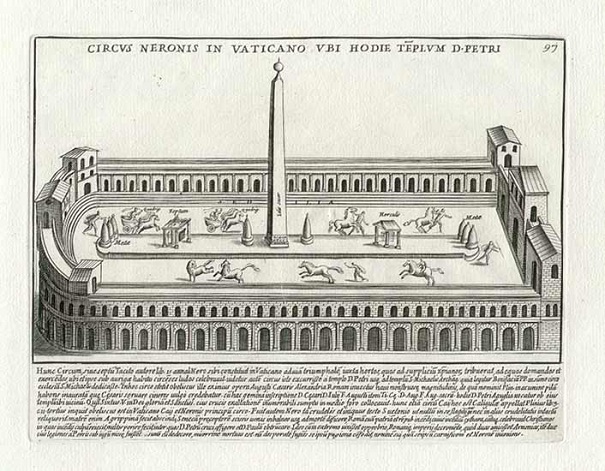 Reconstruction of the Circus of Nero, by Pietro Santi Bartoli, engraver, painter, and draughtsman. Etching circa 1695. Wikipedia
Reconstruction of the Circus of Nero, by Pietro Santi Bartoli, engraver, painter, and draughtsman. Etching circa 1695. WikipediaThis is where Saint Peter is said to have been martyred under Nero's orders in 64 CE. And that's why the basilica stands where it does today.
All About the Obelisk
The obelisk is 25-meters (84 feet) tall, or 40 meters (135 feet) if we count its pedestal, and weighs about 330 tons.
It is supported by four bronze lions at its base and topped by a bronze coat of arms of Pope Sixtus V.
Interestingly, the Vatican obelisk is the only (ancient) obelisk in Rome that never fell and broke apart.
In the Middle Ages, some attributed this to the fact that Nero was a sorcerer. Others have credited the fact that the obelisk was the last witness to the martyrdom of Saint Peter.
At one time, it was topped by a gilt ball that many during the Middle Ages thought contained the ashes of Caesar, Augustus, and Tiberius. Eventually, Domenico Fontana studied the ball and determined that it was single-cast and seamless, and that therefore nothing could be inside - you can see the ball today in the Capitoline Museums.
The obelisk is the oldest thing in St. Peter's Square. It may well be the oldest obelisk in Rome but that distinction officially falls to the Lateran obelisk, near San Giovanni in Lateran, because we are not sure of the exact dating of the Vatican obelisk.
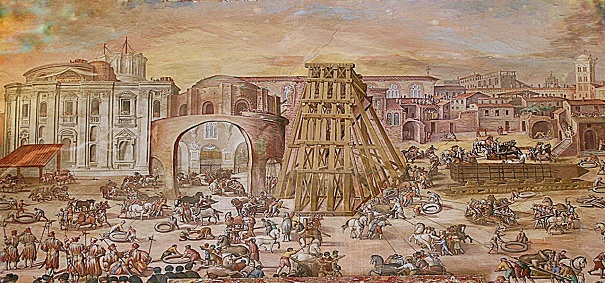 Mural painting (1585-1588) from the Vatican Apostolic Library -. Erection of the obelisk in St. Peter's square.
Wikipedia.org
Mural painting (1585-1588) from the Vatican Apostolic Library -. Erection of the obelisk in St. Peter's square.
Wikipedia.orgOne of my favorite books about this period in Roman history is Murder in the Garden of God, a true story about murder, revenge, and intrigue.
That also tells the story of the Vatican obelisk and how and why Pope Sixtus V had it moved.
Moving the Obelisk
Beginning around the mid-1400's, various popes wanted to move the obelisk from its original spot close to the left transept, so that it would be centered in front of St Peter's Basilica.
This would require moving it just 300 meters (around 800 feet), yet it seemed an impossible task. Supposedly even Michelangelo refused to try.
In 1586 Pope Sixtus V asked for architects and engineers to submit ideas for how to move the obelisk, and over 500 men offered proposals.
In the end, the Pope chose his favorite architect, Domenico Fontana, who'd created a small model that demonstrated how the obelisk could be moved.
The move required 900 men, 75 (or more) horses, and 44 winches. Fontana succeeded on September 10, 1586 after a 5-month long operation. And so the ancient Egyptian obelisk brought to Rome by Emperor Caligula became the first element of what is today St Peters Square.
There's a cute story about this event:
Supposedly, Pope Sixtus V had ordered absolute silence during the delicate operation, on pain of death. But a sharp Genovese sailor by the name of Benedetto Bresca saw that some ropes were fraying from the heavy friction, and he yelled "Acqua alle funi!" (Water on the ropes!).
This saved the obelisk from falling and breaking. Rather than punish him, the Pope rewarded the man by offering him the favor of his choice.
The sailor asked, and was granted, that all the Vatican's Palm Sunday fronds be purchased in his home town of Bordighera. They still are to this day.
Jump start your trip to Rome with a free ebook 😀
Sign-up to our free newsletter and receive our Quick Start Guide to Rome ebook which share's everything you need to know to plan the perfect trip to the Eternal City 🙌
Interesting Things to See in St Peter's Square
The Paving
The obelisk also acts as a sun dial (as many obelisks did in ancient times).
You can follow the sun's shadow along 5 zodiac signs inlaid on the pavement.
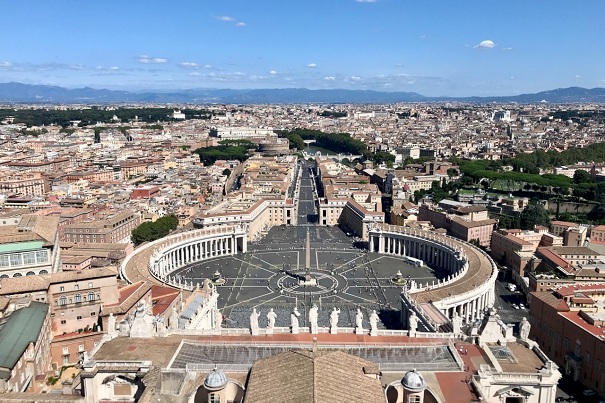 When you look down on St Peters Square from the dome high above, you can appreciate the symmetry of the piazza and the designs in the pavement below.
When you look down on St Peters Square from the dome high above, you can appreciate the symmetry of the piazza and the designs in the pavement below.The piazza is paved with a combination of cobblestones and travertine blocks. The white travertine strips radiate out from the central hub (the obelisk), to further emphasize the symmetry of the square.
Also on the pavement, you'll find two white marble disks, one for the summer solstice and one for the winter solstice.
At noon on December 21, the obelisk's shadow falls on the marble disk furthest from the obelisk's base and then at noon on June 21, the tip of the shadow falls on the marble disk closest to the base of the obelisk.
A long, thin white travertine strip runs across the width of the piazza and acts as meridian line, which indicates when the sun is at its highest point in the sky.
Brief History of the Vatican eBook
The history of the Vatican stretches back thousands of years, and to know everything about this incredible micro-state would take a lifetime to learn.
With this eBook, discover the brief history of the Vatican - where it got its name from, who built the basilica, where the Popes are buried and more!
Topics covered include:
- Details about the Vatican's origin, going back to the time of Ancient Rome
- The role important artists such as Michelangelo played in the creation of the Vatican as we know it today
- How the Vatican came to be an independent city state within the boundaries of Rome
What else is included in this e-book?
- 50+ pages of information covering all areas of the Vatican's history
- Dozens of stunning and original photos showcasing the Vatican
- Insightful diagrams and drawings to help illustrate the more detailed elements of the Vatican's history
- + much more!
The Fountains
In 1613 architect Carlo Maderno (Domenico Fontana's nephew), who'd designed the façade of St Peter's Basilica, modified an existing fountain that was to the right of the obelisk as you faced the church.
His fountain was proclaimed to be the most beautiful fountain in the world at the time.
When Bernini designed the square some 50 years later, he realized that to maintain symmetry, there needed to be an identical copy of Maderno's fountain on the left side.
He may have designed it himself or he may have had his contemporary Carlo Fontana (no relation to either Carlo Maderno or Domenico Fontana) design the fountain, which was completed in 1677.
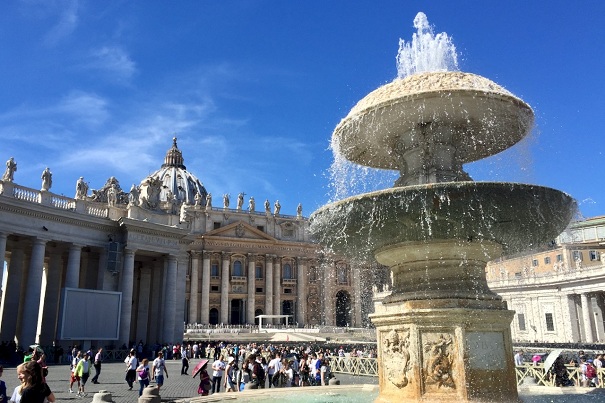 This fountain is a twin of Carlo Maderno's fountain. It may have been designed by Gian Lorenzo Bernini or it may have been by his contemporary, Carlo Fontana.
This fountain is a twin of Carlo Maderno's fountain. It may have been designed by Gian Lorenzo Bernini or it may have been by his contemporary, Carlo Fontana.You can tell the two fountains apart if you look at the coats of arms on the bases.
They represent the popes who commissioned them - The eagle and dragon belong to Pope Paul V (Borghese), while the stars belong to Pope Clement X (Altieri).
The perfect 3-day itinerary in Rome
Trying to figure out how to organize your visit to Rome? I've got the perfect 3-day itinerary for first-time visitors (or those who have not been here in a while.) It works for a 2.5 day visit as well.
In my 3-day itinerary, you'll see all the major must-see Rome attractions like the Vatican, Colosseum, Trevi Fountain, Pantheon, Piazza Navona, Spanish Steps, and much more.
And if you have more time, or want suggestions for extra/other things to do, you'll find that there too.
Visit my page with the best 3-day itinerary in Rome for first-timers.
The Colonnade
Bernini designed his colonnade so that it would seem as if the two arms were reaching out in a giant embrace. The shape symbolized the arms of the church embracing the world.
The colonnades consist of four rows of Doric columns, for a total of 284, with 88 pilasters, with columns that are 20 meters high (66 ft) and 1.6 meters wide (5ft).
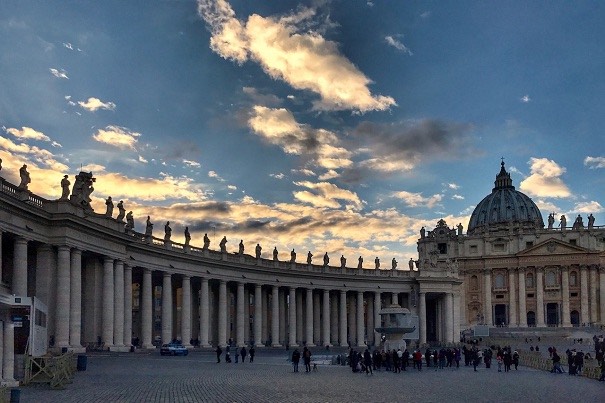 Sunset at St. Peter's Square. Details of the facade of the Basilica and the Colonnade by G.L. Bernini.
Sunset at St. Peter's Square. Details of the facade of the Basilica and the Colonnade by G.L. Bernini.The columns are 4-deep, which results in 3 parallel lanes.
You can drive down the central one, and the other lanes are for pedestrians only.
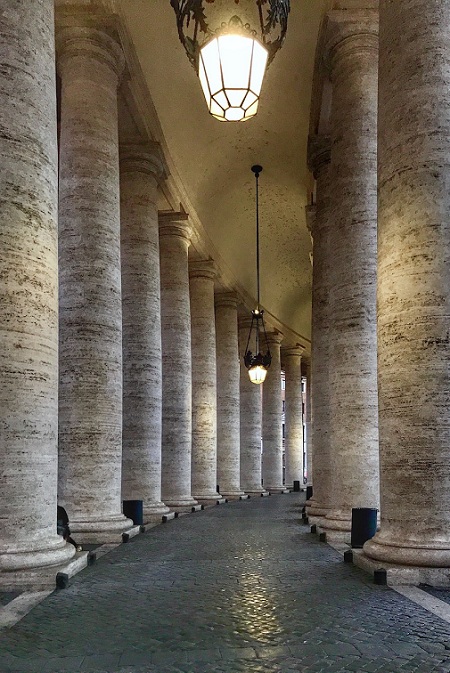
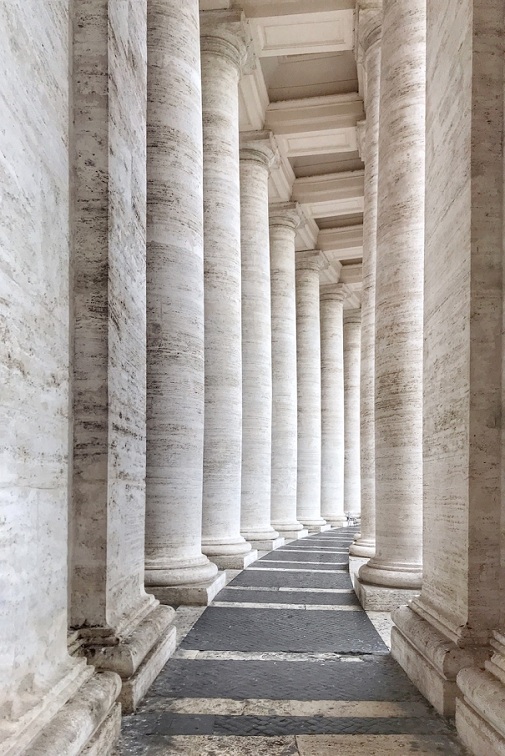
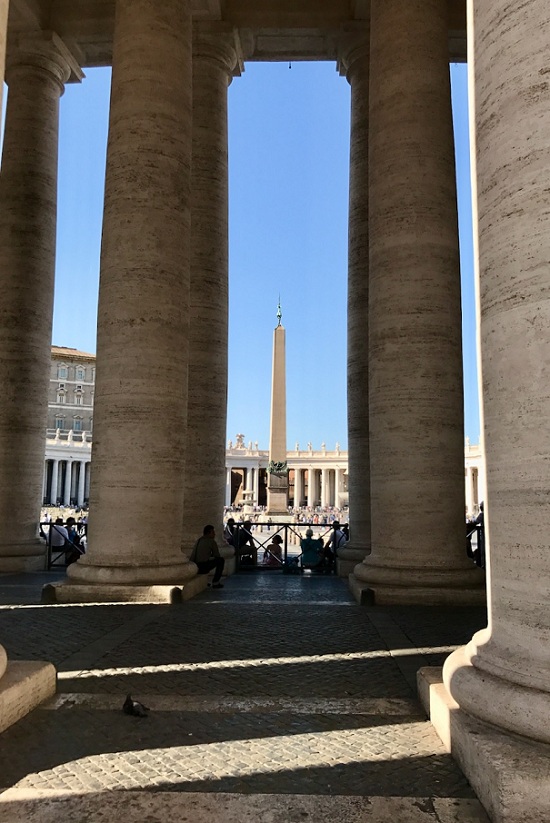
The colonnade is crowned with the Chigi coats of arms, as he (Pope Alexander VII) was the one who commissioned it.
In fact you will see his coat of arms in a lot of places in St Peters Square and in many other spots around Rome.
The Statues
On top of Bernini's colonnade are 140 statues of saints, which were made by disciples of Bernini in 1670.
They are about 3 meters (9 feet) tall, and represent many important figures in Catholicism, like popes, saints, and martyrs. Thirty-eight of the statues depict women.
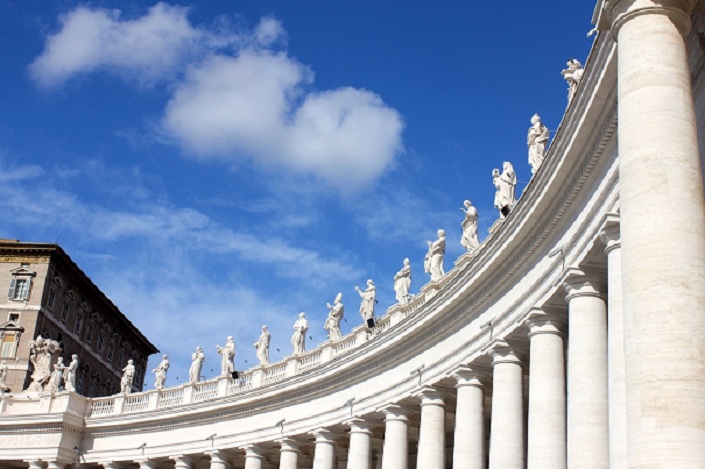 St. Peter's Square as well as a symbolic monument of the Italian Baroque is also one of the most classic constructions built after the Renaissance.
St. Peter's Square as well as a symbolic monument of the Italian Baroque is also one of the most classic constructions built after the Renaissance.You will also see two statues on either side of the basilica, representing Saints Peter and Paul, patron saints of Rome.
Optical Illusions
One fun thing to do in St Peters Square is to check out the optical illusions.
The first optical illusion involves Saint Peter's dome.
If you stand right underneath the façade, you can't even see the dome.
The further you move away from the façade, and even out of St Peters Square, the more and more you will see of the dome, and the taller it will seem.
The best way to see Saint Peter's dome is not even in St Peters Square, but from a bridge on the Tiber river.
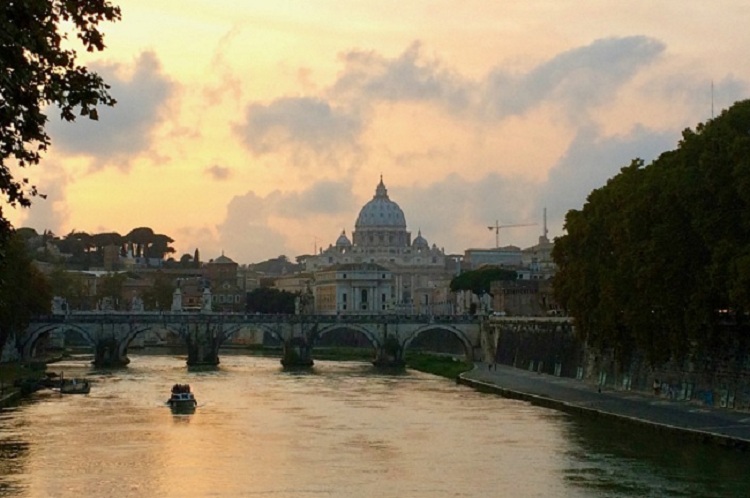 One of the best ways to see Michelangelo's dome is from one of the bridges on the Tiber river. The closer you get to St Peters Basilica, the less you see of the dome.
One of the best ways to see Michelangelo's dome is from one of the bridges on the Tiber river. The closer you get to St Peters Basilica, the less you see of the dome.The second optical illusion is the colonnade itself.
Just next to the obelisk in the center of the square, look for the circular marble plates that indicate the foci of the ellipse. They have the phrase "centro del colonnato" (center of the colonnade) on them.
If you stand on either one of these and look towards the colonnade, you will see only one row of perfectly aligned columns instead of four.
The Border Between Italy and Vatican City
The colonnade marks the border between Italy and Vatican State.
A strip of travertine on the ground joins the two ends of the colonnade, and marks the border between the two countries.
You can freely cross this line, there are no border controls or passport checks to worry about.
If you like, you can purchase special Vatican City stamps from the post office to the side of St Peter's Square as a souvenir of your trip.
Bernini's Heart/Nero's Heart
Right near the obelisk, you can spot a stone that represents the Rose of the Winds, with the southwest wind the “libeccio”.
One of the nearby cobblestones is in the shape of a heart (you have to look pretty carefully).
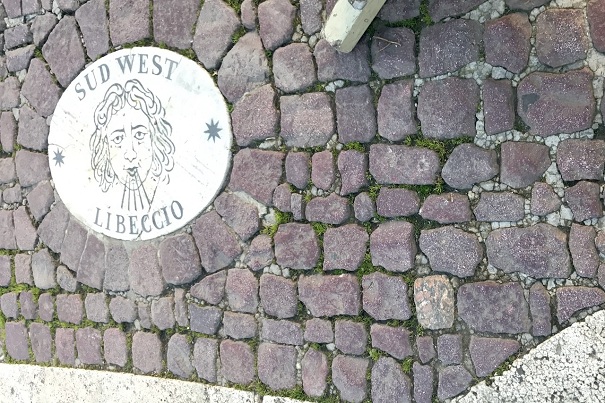 The Rose of the Winds, set in the pebbles.
The pavement of St. Peter's Square is made up of about 2 million pebbles known as "flints" or cobblestones.
The Rose of the Winds, set in the pebbles.
The pavement of St. Peter's Square is made up of about 2 million pebbles known as "flints" or cobblestones.Depending on which legend you prefer, this is either:
- The heart of Roman Emperor Nero, responsible for the death of Saint Peter in Nero's nearby circus, who has re-emerged from the grave, like a curse on the church.
- The work of Bernini, as a symbol of a lost love.
- The work of Michelangelo, as a symbol of broken heart.
- Put there by a woman to remember her husband who was unjustly sentenced to death.
Experience St. Peter’s Basilica like never before with this special tour that takes you beyond the surface.
From top to bottom: climb the dome for breathtaking views, then head head underground to the papal crypts.
What Events Take Place in St Peters Square?
On most Wednesdays when the Pope is in town, the Pope gives the Papal Audience in St Peters Square.
The exceptions are July, when the Pope is generally on vacation, and on very cold or rainy days when the audience is held inside the Paul VI Hall instead.
On Sundays when the Pope is in town, he delivers the Angelus Domini from a window of the Apostolic Palace.
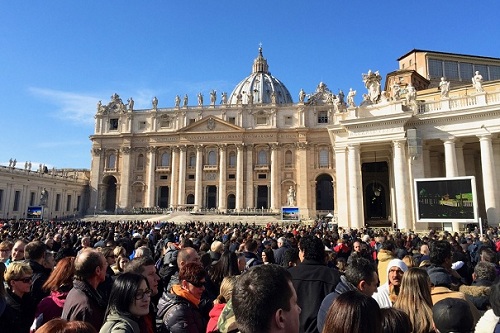 On Sundays when the Pope gives the Angelus Domini, St Peter's Square fills up so people can watch him deliver the Angelus from a window above.
On Sundays when the Pope gives the Angelus Domini, St Peter's Square fills up so people can watch him deliver the Angelus from a window above.On special occasions, such as the election of a new pope, a canonization, or on Easter, 3-400,000 people can fill the huge square.
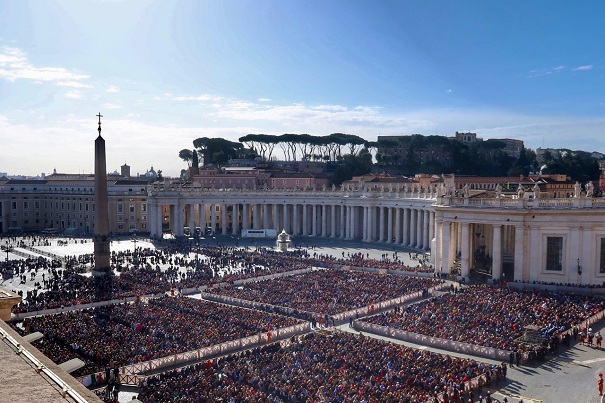 One year I had the privilege of attending Easter Mass at the Vatican, and got to see St Peters Square from high above.
One year I had the privilege of attending Easter Mass at the Vatican, and got to see St Peters Square from high above.St Peters Square is a beautiful place to visit at Christmas, when there is a gorgeous tree and life-sized nativity scene right in the center.
When Can You Visit St Peters Square?
St Peters Square is free to visit and open daily from around 6:30AM through to around 11PM. These times are dependent on the police in the square and are not strictly adhered to all the time.
It used to be wide open even all night long but in recent years they put up a small barricade and now it's closed at night.
You may freely visit St Peter's Square as long as there is no event happening there, such as a Papal Mass or Audience. For any such event, you can expect to have to go through security before you even set foot in the square.
Don't forget, when you cross over the white line onto the square, you are literally leaving one country (Italy) and entering another one (Vatican state.)
Ready to plan your trip?
Book your train
Planning to travel between cities in Italy and other parts of Europe?
Use Trainline to see all the different options available across the different rail companies.
Find your hotel
Find your perfect place to stay in Rome.
Use Booking.com to choose between hotels, guesthouses, and self-catering apartments in neighborhoods throughout the Eternal City.
Buy your TurboPass
Purchase the convenient Turbopass and visit all of Rome's top attractions including the Colosseum, Pantheon, and Vatican.
With one handy pass, it's all included.
How to Reach St Peters Square?
Vatican City is on the west side of River Tiber.
Most of the other tourist attractions in Rome (Pantheon, Spanish Steps, Trevi Fountain, Colosseum, Piazza Navona) are on the east side. So you'll need to cross the Tiber River to visit St Peters Square.
Until the Mussolini era, there was a dense neighborhood full of buildings from the Medeival all the way through the Baroque periods.
This was known as the spina del Borgo. It divided the roads of Borgo Vecchio and Borgo Nuovo but in 1936 this entire area was demolished by Benito Mussolini.
As a result, you could see St Peter's Basilica unobstructed all the way from Castel Sant'Angelo.
Once this demolition was completed, most of the rest of the buildings in the area were also demolished (1937-1950). Priceless historical buildings, including places where Michelangelo and Raphael worked and lived, were destroyed forever.
On Foot
The best way to arrive at St Peters Square is by walking up the Via della Conciliazione, a street that begins at Castel Sant'Angelo.
This gives you a dramatic introduction to the square and the basilica as you move closer. You can also enter St Peters Square from either side.
By Public Transport
Besides walking, you can also reach St. Peter's Square using public transport.
From Rome center, the easiest way to get to the Vatican is with the Metro.
Take the red line A to Ottavianom and when you get out of the station, you won't see the Vatican but just follow the crowds.
Walk down Via Ottaviano until Piazza Risorgimento. Continue to Via di Porta Angelica at the end of which you will catch a glimpse of the famous colonnade through a small archway.
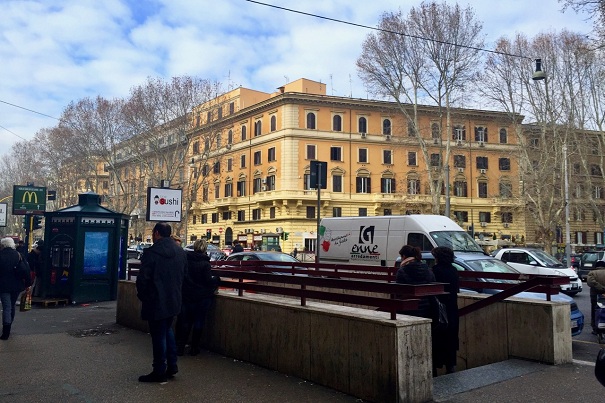 This is the Ottaviano metro stop. You won't see St Peters Square from here, but it's not far. Just follow the signs and/or the crowds.
This is the Ottaviano metro stop. You won't see St Peters Square from here, but it's not far. Just follow the signs and/or the crowds.You can also get to St Peters Square by bus. Multiple lines stop nearby, either near the square, Castel Sant'Angelo or Piazza del Risorgimento, depending on where you start from.
There will always be a little bit of a walk to reach the Vatican, as there is a pedestrian area all around it.
From Civitavecchia
If you are coming to St Peters Square for a visit to the Vatican on a cruise stop, you can easily take the train.
At Civitavecchia train station take the first Rome-bound regional train. The ride should take under an hour. Get off at Roma San Pietro Train Station and it's about a 10-minute walk to the square from there.
Romewise's Top Travel Resources
Ready to book your trip to Rome? Take a look at these helpful links to companies we use and trust:
- Keep your travel spending simple with the Wise card, which removes all the worry about exchange rates and high transaction fees all over the world
- Search for and book your perfect accommodation
- Our complete guide to what to pack for Rome
- The number one travel accessory, a multi-point travel adapter and voltage converter
- Browse a huge range of tours in Rome and beyond
- Experience unique tours and special access to Rome's most popular sights
- Protect yourself with comprehensive travel insurance
Within this post there are some affiliate links for products and services. For more details about our affiliate policy click here.
Get your 100% free Rome trip planner now!
Simply sign-up today for our free newsletter and get the Romewise Quick Start guide to Rome:
We are committed to respecting your data. Click for our Privacy Policy.
Comments? Questions? Suggestions?
Please come over to the private Romewise Facebook group and join in the conversation.
You will often find me there, happy to answer your questions / comments!
You will also meet other Rome lovers and experts, too.
What are you waiting for?
- Romewise Home Page
- Visiting the Vatican
- St Peters Square

